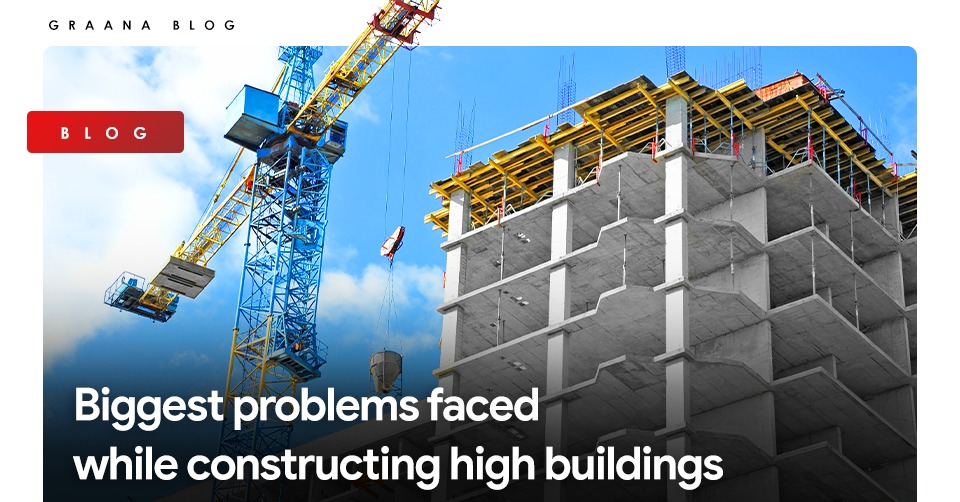
High-rise buildings are the solution to high-density challenges and the scarcity of sufficient land for development. They have the ability to alleviate congestion due to urban sprawl. A high-rise structure has a compact footprint, limited space, and a massive façade.
As structures rise in height and geometry becomes more complex, structural engineers are more forced to push the boundaries of what is achievable. There are multiple advantages and disadvantages of high-rise buildings that will be covered in this blog.
High-rise construction has played a pivotal role in the development of urban cityscapes. The process of constructing a high-rise structure is complicated, and it necessitates careful consideration of a number of elements, e.g., natural disasters like earthquakes, flooding, wind, hurricanes, blizzards, etc.
Extensive studies about varying wind accelerations between surface and higher levels and elastic contraction of building components as the mass of the building increase are also major factors to be considered.
Careful measures need to be implemented to ensure that the building remains level, truly vertical, and not get affected by environmental changes.
Graana.com brings you a list of challenges that arise in the construction of high-rise buildings.
The wind is one of the most critical factors that determine the structure of a building and necessitates lateral structural design. Round, concaved corners, squared, or virtually spherical structures are recommended for high-rise buildings.
The residents of a building may experience discomfort in the event of large deflections and vibrations. Tall buildings sway in the wind if the movement is too great and the fabric of the building may be harmed.
If the accelerations are too high, people may feel nauseated or seasick. Base isolation is used in high-rise buildings to make sure that the ground below can move without sending the minimum motion to the structure above. Turbulent winds can drastically affect high-rise buildings if they are not constructed up to the mark.
Since fires in high-rise structures can cause significant damage, fire safety is a primary issue for high-rise construction. High-rise buildings should be constructed following strict building codes.
Smoke Detectors, Sprinklers, and a First Aid Fire Fighting System should all be placed in high-rise buildings.
It is necessary to construct proper fire escape routes, a fireman lift, service shaft enclosures, compact mentation, and an approved electrical system to avoid any future disaster.
Due to the extreme need for parking services in high-rise structures, basements are nearly a must, whether it is a residential building or a commercial plaza.
This poses a great challenge for designers and engineers to construct in a manner that can utilize maximum space for the basement.
When building taller structures, lift technology can be a limiting element. It’s a major concern since the steel wires that suspend lifts are put under a lot of stress, largely from their own weight, especially on turbulent windy days. In extreme weather conditions, lifts may even be shut down because they are easily influenced by building movement.
Elevators in high skyscrapers need to be constructed carefully, and their functionality is carefully monitored. It is preferable to use super-light rope technology with a carbon-fiber core and a higher strength coating. Though the number of elevators is not a barrier at the moment, they will be streamlined in the future to account for technological advancements.
While constructing high-rise buildings, extra caution needs to be taken. High-rise construction can pose a variety of problems for other structures in the nearby vicinity.
To ensure that the construction does not interrupt or undermine surrounding structures or foundations, certain prerequisites must be exercised.
Commuters and transportation must continue to pass near where workers are establishing giant glass windows and concrete structures, contributing to the overall construction risk.
Safety concerns are one of the major concerns during the construction of high-rise structures. It involves workers’ safety along with environmental safety. A lot of workers die during this process. The risks have been mitigated with advanced technology and digitalization in many areas.
A lot of potential safety hazards can now be detected earlier, and action can be taken. Builders, contractors, and others have real-time, on-site access to information and visualizations in the field, allowing them to spot risks and tolerances and communicate information timely.
Another problem is the repair and maintenance of high-rise structures and services, including physical exterior cleaning, which may eventually be replaced by automated maintenance. The expenditures for maintenance and repair are also significant in such structures.
For architects and engineers, providing convenient access to service maintenance is also a challenge. In high-rise buildings, the choice of materials that require little or minimal care should be prioritized.
Lift malfunctions, limited parking, sanitation, waste disposal, and overall coordination are some of the concerns that arise. For taller structures, management staff cooperation is also a significant obstacle. The higher the building is, the greater it is a challenge to smoothly maintain operations.
With the technological advancements and incorporation of IoT, a lot of the aforementioned challenges can be solved.
Dubai’s residential real estate market maintained its upward momentum in November 2025, with the latest…
Saudi Arabia’s Real Estate General Authority (REGA) has announced the launch of a new platform…
Dubai: Tomorrow World Group, a global enterprise with a 20-year presence in the emirate, has…
Islamabad: The Capital Development Authority has begun a citywide rehabilitation and upgrading campaign, starting…
Dubai: The emirate’s real estate sector continued its strong performance in November 2025, posting transactions…
The 19th Real Estate Development Summit Saudi Arabia Luxury Edition ended after two days of…